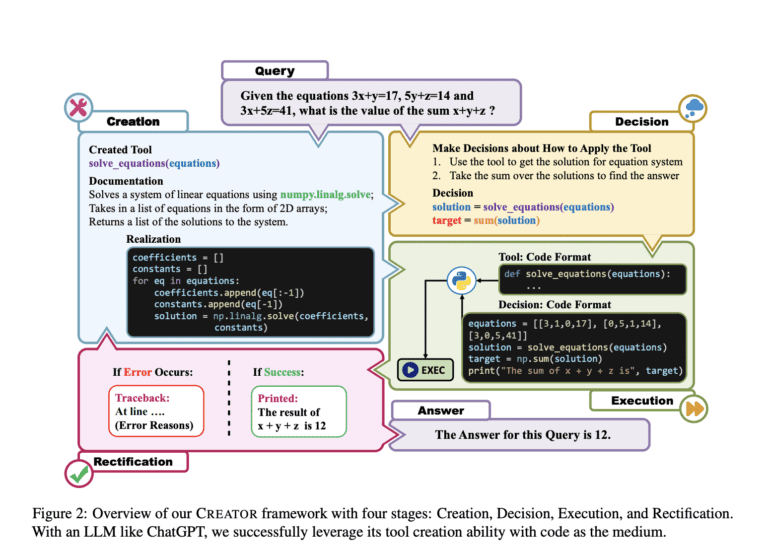TL;DR:
- LLMs like GPT-3 and ChatGPT have shown impressive advancements in AI.
- Despite progress, LLMs still face limitations in handling present information and complex reasoning.
- External tools have been integrated to improve problem-solving, but challenges persist.
- Researchers from Tsinghua University and the University of Illinois introduce CREATOR, empowering LLMs to create their own tools.
- CREATOR allows LLMs to fine-tune tools for specific problems, enhancing accuracy and flexibility.
- This framework marks a significant leap toward Artificial General Intelligence.
Main AI News:
In the fast-paced world of large language models (LLMs), revolutionary advancements have been witnessed in recent years. With cutting-edge models like GPT-3, Codex, PaLM, LLaMA, ChatGPT, and the latest GPT4, LLMs are steadily advancing toward Artificial General Intelligence. Their outstanding performance in in-context learning, code generation, and diverse NLP tasks has been nothing short of remarkable. However, as with any technology, there are challenges to overcome. Current LLMs still face limitations, such as the inability to recognize and respond to present information, difficulties in providing precise mathematical solutions, and occasional instability in reasoning through complex logic chains.
In response to these shortcomings, researchers have embarked on a journey to equip LLMs with external tools to alleviate their memorization burden and enhance problem-solving capabilities. For instance, incorporating web search engines and question-and-answer (QA) systems allow LLMs to learn how to leverage external resources effectively. Recent studies have also explored the integration of additional external LLM tools, including GitHub resources, neural network models (such as the Huggingface module), and code interpreters (like the Python interpreter). However, utilizing these tools requires extensive planning and blueprinting, presenting cognitive challenges and high learning costs.
Despite progress, tool-augmented LLMs still face significant obstacles, particularly in three critical areas. Firstly, the range of potential innovative tasks is vast, but the current focus often revolves around only a limited set of tools, making it challenging to find appropriate solutions for new problems. Secondly, the process of deducing the most effective tool usage is inherently complex, requiring extensive planning and straining the models’ cognitive capabilities. And thirdly, existing tool-use pipelines lack a well-defined and automated error-handling mechanism, necessitating further development to ensure accuracy and robustness.
To tackle these challenges, a collaborative effort between Tsinghua University and the University of Illinois (UC) has resulted in the CREATOR framework. CREATOR takes a fresh approach by empowering LLMs to be the creators of tools rather than just consumers. With this novel framework, LLMs can develop and fine-tune tools based on existing parameters, enabling them to address specific problems with enhanced accuracy and flexibility. Figure 1 illustrates the contrasting pipeline variations between CREATOR and conventional tool-using frameworks. While traditional approaches focus on reasoning and planning the use of APIs, CREATOR emphasizes diversifying the toolset, decoupling levels of rationale, and improving the overall resilience and correctness of the framework.
Conclusion:
The introduction of CREATOR represents a remarkable advancement in the capabilities of large language models. By enabling LLMs to develop and adapt their own tools, the framework addresses existing limitations and enhances problem-solving capabilities. This innovation is poised to have a transformative impact on the market, as businesses can harness the power of more autonomous and versatile AI systems to drive innovation, efficiency, and competitiveness. Embracing CREATOR and the potential of AI advancements will be crucial for staying at the forefront of technological progress in today’s competitive landscape.

